Balancing time against money is always a factor when deciding whether to do something yourself or hire a professional. If you’ve been following my home remodels, you know I do a lot of skim coating. Smoothing wall texture can be a time consuming task. You can hire a professional to retexture walls for you. OR you can learn how to remove wall texture yourself. One will cost you cash. The other will cost you time. In this post I’m showing you how to skim coat over wall texture to create a smooth finish. For those of you that decide to DIY it!
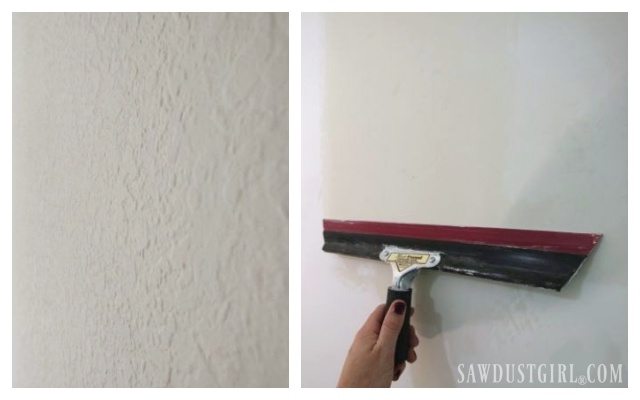
Uneven wall texture patterns
The walls in this house are worse than any other home I’ve remodeled. The heavy knock down texture was not applied unevenly throughout the house. In some areas there are just a few random blobs. Other areas REALLY got splattered but never got “knocked down”.
In order to achieve uniformity, one person needs to texture entire walls and rooms. If possible the entire house. If that’s not possible, everyone doing the texturing needs to use the same technique.
It would be difficult for a single person to texture a 6000 sq/ft house. So either more than one person did the job. OR one person did do the job and got sick of it halfway through and just started slopping joint compound on the walls!
Either way, now I have to fix it. I need all the walls in my house to have a uniform quality of workmanship. Some people might not care about that. Wha? I do!
Retexturing vs smooth finish
In order to retexture the walls and create uniformity, I’d have to smooth the existing texture first. Then I could pour some ready mix joint compound into a hopper, spray it on and knock it down. I’m not even a fan of heavy texture patterns so I’m going to skip all the parts I said after, “smooth the existing texture”!
Yep, all the texture is going, going… I’d love to say, “Gone” but I still have about 4000 sq/ft left to skim coat! But I’m getting there. Slowly and surely.
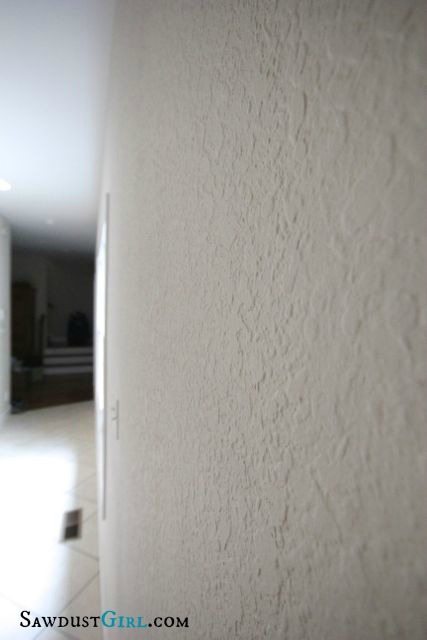
DIY or hire a Pro? (Time vs Money)
I like a smooth finish on walls and ceilings. It definitely requires more finesse to create a smooth, flat finish than it does to apply texture. It’s something most people can tackle if they have the patience to practice and really master the technique. If not, I suggest hiring it out.
Drywall work can get really messy. Professionals know to cover the floors, mask everything off and contain the dust! Most DIYers just want to jump in and get it done. So they end up cleaning drywall dust out of every nook and cranny of their house for a few months.
Professional tapers spend thousands of dollars on equipment. It makes sense for them to invest that kind of money. Taping, mudding and texturing is what they do, day in and day out. Expensive tools let them do a better job in a shorter amount of time.
If skim coating is a “once in a blue moon” sort of task, you don’t need to spend a lot of money buying fancy tools to do it. It will take you longer and it probably won’t look quite as good as what a seasoned pro could do. But you can get a nice smooth finish with minimal tools.
Balancing time against money is always a factor when deciding whether to do something yourself or hire a professional.
Gather your supplies
If you’re still reading, you’ve decided to tackle this job yourself. Way to go! You’ll need to gather a few supplies:
- Paint tray or 5 gallon bucket
- a thick nap paint roller
- a spray bottle of water
- water to thin you joint compound
- a wet rag
- a Magic Trowel
- drop cloth (cover your floors)
If you’re doing a small room where you’ll only need one bucket, I’d choose a ready mix joint compound. It costs about $15 for a 5 gallon bucket. So for $15 you get the mud and a bucket.
Dry joint compound is much cheaper. You can get about 4 times the coverage with dry mix mud. If you’re doing a LOT of skim coating, dry is probably a cost effective option. You still need the 5 gallon bucket which runs about $4-5.
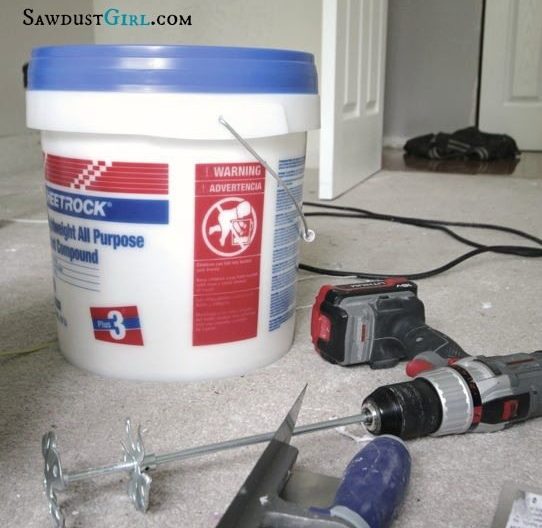
Skim Coating
Skim coating means applying a thin layer of joint compound or plaster to your walls. There are lots of different tools you can use to skim coat. In this post I’m showing you how to use the Magic Trowel. It is available in several sizes. I like the 18″ or 22″. Too big is hard to manage and too small takes forever to make any progress.
You’re going to be applying the joint compound (mud)to the walls using a thick nap paint roller. You can use a paint tray or dip the roller right into the 5 gallon bucket of mud.
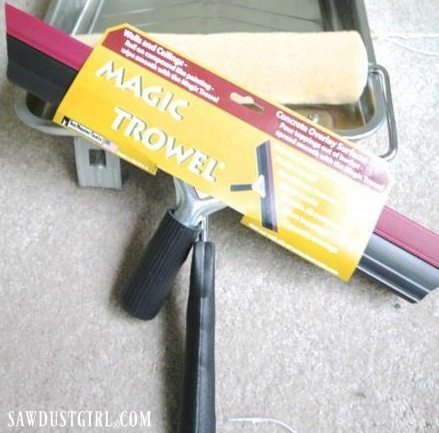
Prepare the joint compound
Mix the joint compound to the consistency of thick pancake batter. It’s got to be thin enough for you to smooth it on the wall but not so thin that it just drips and dribbles down the wall. You may have to play around with it until you get the “just right” consistency.
If you’re using ready mix mud, add a little water at a time so you don’t end up making it too runny. This is where dry mix can be beneficial. If it does end up too runny, add more dry mix.
Mixing skim coat compound reminds me of making powdered sugar frosting. I always end up having to add more milk and then more sugar at least 3 times each!
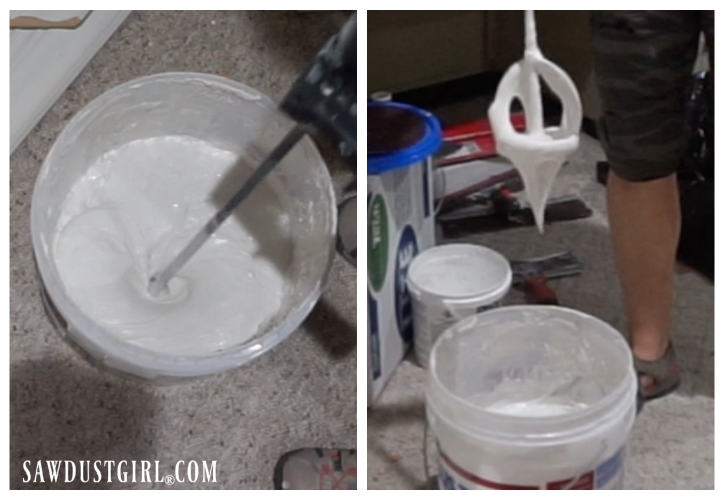
Apply joint compound to wall
Using a thick nap paint roller, apply a generous amount of mud to the wall. Using a roller allows you to get more compound on the wall faster than if you were scooping it out with a taping knife. You can pour joint compound into a roller tray or dip the roller directly into the 5 gallon bucket.
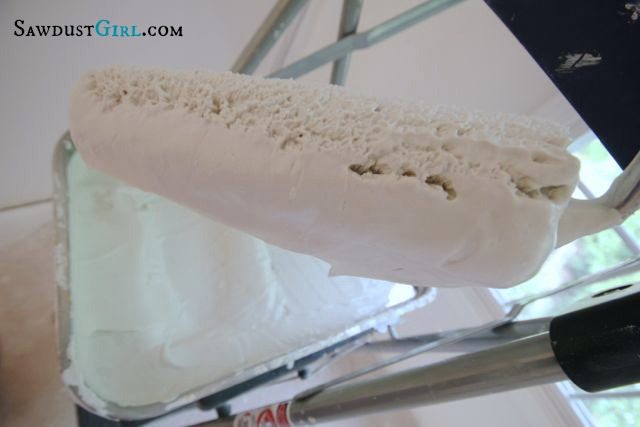
I generally prefer the bucket method because it’s faster. However, it is also messier. So–choose your poison.
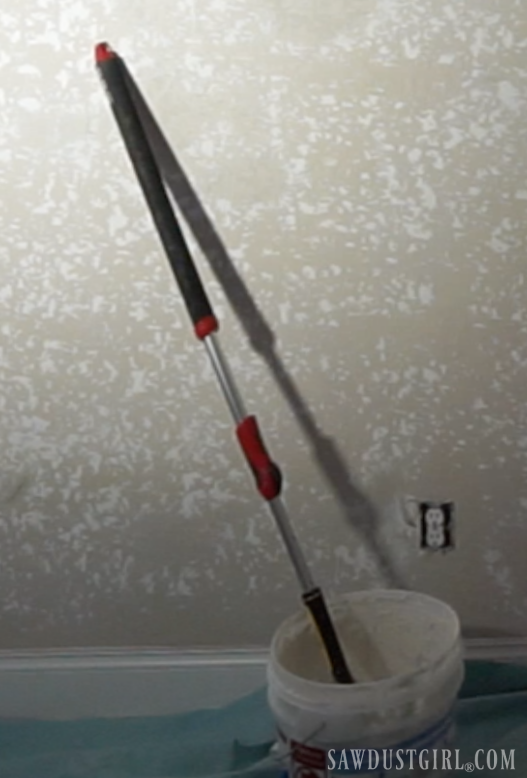
Only apply mud to a small section of wall at a time. Otherwise, the joint compound will start to dry before you get a chance to smooth it all out. I work in 4’x4′ sections.
Create a smooth finish
After rolling the mud onto your first section, use the magic trowel to smooth it out. The first coat won’t be perfectly smooth. The compound is filling the voids that around the raised surfaces in the existing texture. If you have a really heavy texture, you’ll need more layers of joint compound. It’s a process.
- Each coat of mud should be smoothed in the same direction as it was applied onto the wall with the roller.
- Alternate directions of each consecutive coat.
- If you rolled the mud onto the wall vertically on the first coat, switch to horizontal application for the next coat.
After smoothing out your first section of wall, you’re ready to roll another section with joint compound.
- Make sure to keep a wet edge. That’s where the spray bottle full of water comes in handy. Before you start rolling compound onto your second section, lightly mist the edge of the area you just smoothed.
- Slightly overlap the first section as you roll the second section.
Using the Magic Trowel
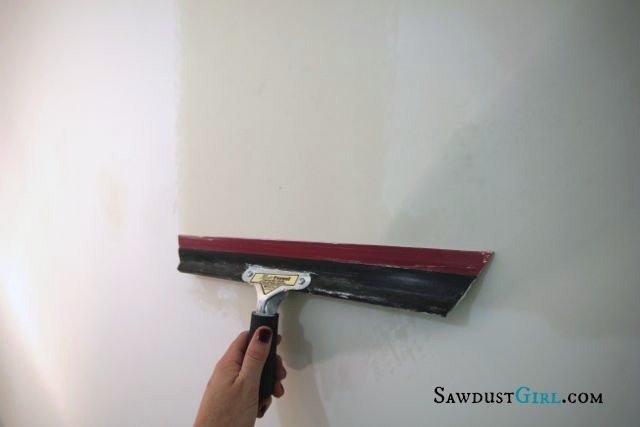
The Magic Trowel is like a squeegee. It’s a rubber blade on a handle. It does come with a cover over the blade. Make sure to remove the blade cover!
- Use your damp rag or spray bottle to wet the blade before use.
- Pull the Magic Trowel over the compound, smoothing it out.
- Squeegee the mud in the same direction that you applied it with the paint roller.
If you have really heavily texture patterns, the first coat will not produce perfectly smooth walls. The Magic Trowel may create new lines. Don’t freak out. The next coat will fix that.
Light your work surface

Shining a light at an angle on the wall you’re working on. The angle is important because it allows you to see more imperfections than you see with down lighting. This is true when painting as well. When you think you’re done, move the light so it’s shining from a different angle. You’ll be surprised to see how many areas you missed. The below picture demonstrates a wall I thought was finished until I moved the light and illuminated my wall from a different angle.
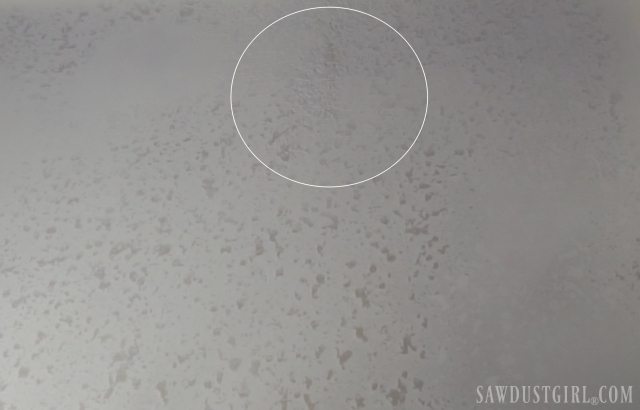
Sanding Drywall
You can lightly sand in between coats but it’s not necessary. Each consecutive coat with the Magic Trowel will make the wall more and more smooth. If anything, you may have lines created by the excess mud sliding off the edge of the trowel as you skimmed over the wall. These lines are very easy to get rid of with a quick sanding.
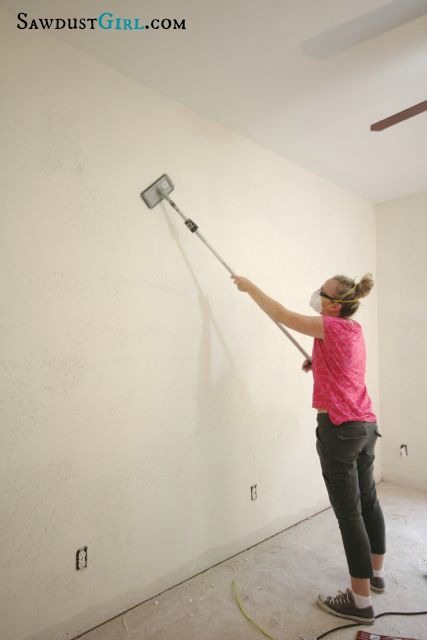
Drywall sanding can be VERY dusty. You shouldn’t have much to sand after skim coating. Just a gentle sanding over the whole surface with a very light grit sandpaper. Sanding without a vacuum attachment will make a BIG MESS everywhere in your house. You have 3 options:
- Use a regular pole sander and worry about cleaning up the dust later. Make sure you wear a dust mask or respirator.
- Wet sand. Use a slightly damp tiling sponge to gently rub away lines and imperfections.
- Use a dust free drywall sander (This is definitely worth the $30 price tag.)
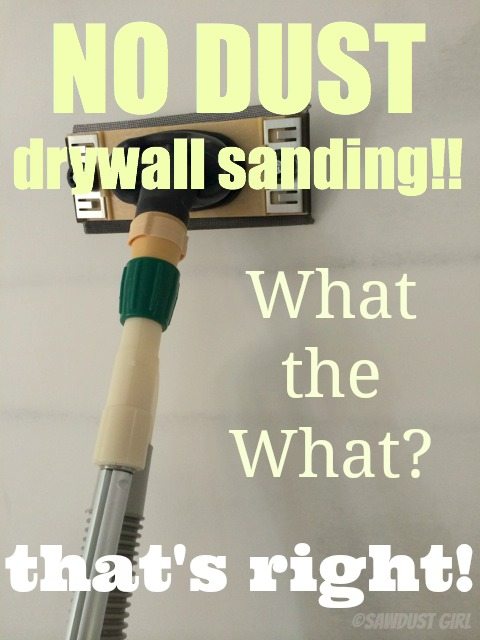
You can also use a box fan to reduce dust when sanding drywall.
How to Skim Coat Walls Video
Want to see and hear me explain how to get rid of ugly wall texture, watch this…it’s an old video that I made when I had NO clue how to make a “how to” video. I should totally make a new video!
I’ll be frank with you, skim coating is messy. It takes some practice to learn the skill. It’s hard work. It’s tiring and can be frustrating. But smooth walls are worth the effort!
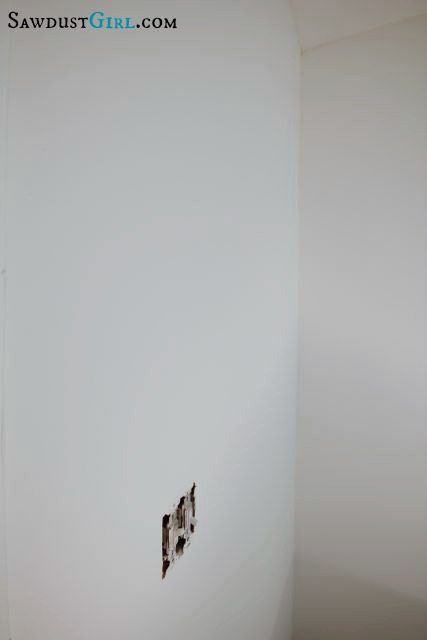
Right?
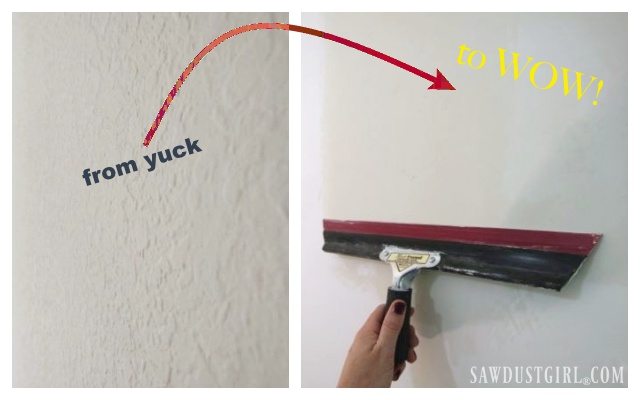
It’s definitely a personal thing. Some people like orange peel and other textured finishes. Give me a crisp, clean, smooth wall any day of the week! So what do you think? Now that you know how to skim coat, are you going to give it a try? Just remember to protect your floors. Unless you’re working in a room where you’re going to remove the carpet. If that’s the case, go ahead and use that carpet as your drop cloth and don’t worry if you drop blobs of joint compound. Just don’t step in them and track it all over the house. Ehem…lesson learned!
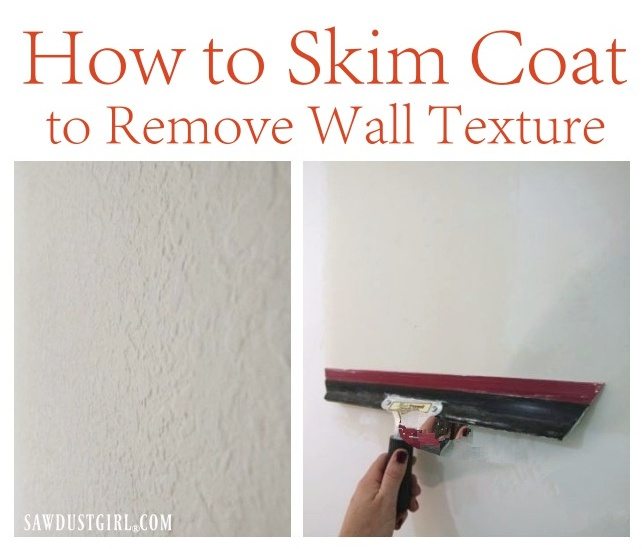
Original article and pictures take sawdustgirl.com site
Комментариев нет:
Отправить комментарий